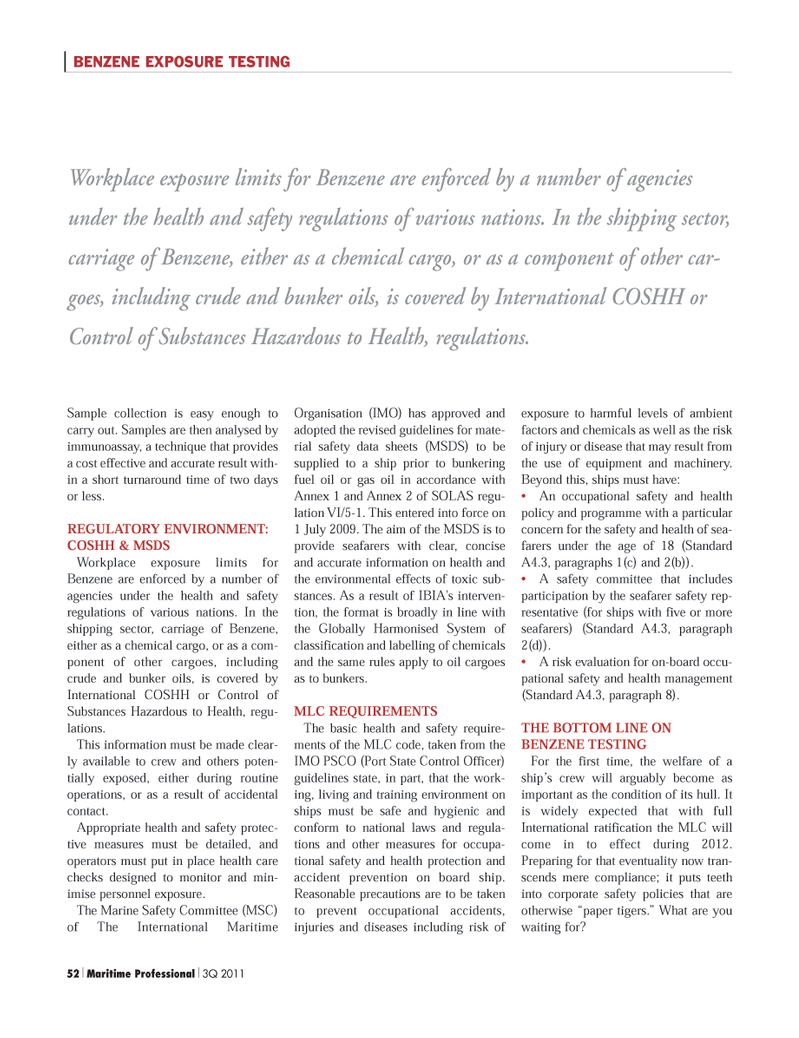
Page 52: of Maritime Logistics Professional Magazine (Q3 2011)
Maritime Security / Maritime Training & Education
Read this page in Pdf, Flash or Html5 edition of Q3 2011 Maritime Logistics Professional Magazine
52 Maritime Professional 3Q 2011Sample collection is easy enough tocarry out. Samples are then analysed byimmunoassay, a technique that provides a cost effective and accurate result with- in a short turnaround time of two days or less. REGULATORY ENVIRONMENT: COSHH & MSDSWorkplace exposure limits for Benzene are enforced by a number ofagencies under the health and safetyregulations of various nations. In the shipping sector, carriage of Benzene, either as a chemical cargo, or as a com- ponent of other cargoes, including crude and bunker oils, is covered by International COSHH or Control ofSubstances Hazardous to Health, regu- lations. This information must be made clear-ly available to crew and others poten- tially exposed, either during routine operations, or as a result of accidentalcontact. Appropriate health and safety protec-tive measures must be detailed, and operators must put in place health carechecks designed to monitor and min-imise personnel exposure. The Marine Safety Committee (MSC)of The International Maritime Organisation (IMO) has approved and adopted the revised guidelines for mate- rial safety data sheets (MSDS) to besupplied to a ship prior to bunkering fuel oil or gas oil in accordance withAnnex 1 and Annex 2 of SOLAS regu- lation VI/5-1. This entered into force on 1 July 2009. The aim of the MSDS is to provide seafarers with clear, concise and accurate information on health andthe environmental effects of toxic sub- stances. As a result of IBIA's interven- tion, the format is broadly in line withthe Globally Harmonised System ofclassification and labelling of chemicals and the same rules apply to oil cargoes as to bunkers. MLC REQUIREMENTS The basic health and safety require-ments of the MLC code, taken from theIMO PSCO (Port State Control Officer) guidelines state, in part, that the work- ing, living and training environment on ships must be safe and hygienic andconform to national laws and regula- tions and other measures for occupa-tional safety and health protection andaccident prevention on board ship. Reasonable precautions are to be taken to prevent occupational accidents, injuries and diseases including risk ofexposure to harmful levels of ambient factors and chemicals as well as the risk of injury or disease that may result fromthe use of equipment and machinery. Beyond this, ships must have: An occupational safety and healthpolicy and programme with a particularconcern for the safety and health of sea-farers under the age of 18 (Standard A4.3, paragraphs 1(c) and 2(b)).A safety committee that includesparticipation by the seafarer safety rep-resentative (for ships with five or more seafarers) (Standard A4.3, paragraph 2(d)).A risk evaluation for on-board occu- pational safety and health management(Standard A4.3, paragraph 8).THE BOTTOM LINE ON BENZENE TESTINGFor the first time, the welfare of a ship?s crew will arguably become as important as the condition of its hull. Itis widely expected that with full International ratification the MLC will come in to effect during 2012. Preparing for that eventuality now tran- scends mere compliance; it puts teethinto corporate safety policies that areotherwise ?paper tigers.? What are you waiting for? BENZENE EXPOSURE TESTINGWorkplace exposure limits for Benzene are enforced by a number of agencies under the health and safety regulations of various nations. In the shipping sector, carriage of Benzene, either as a chemical cargo, or as a component of other car- goes, including crude and bunker oils, is covered by International COSHH or Control of Substances Hazardous to Health, regulations. MP #3 (50-64):MP Layouts 8/17/2011 4:37 PM Page 52

 51
51

 53
53
